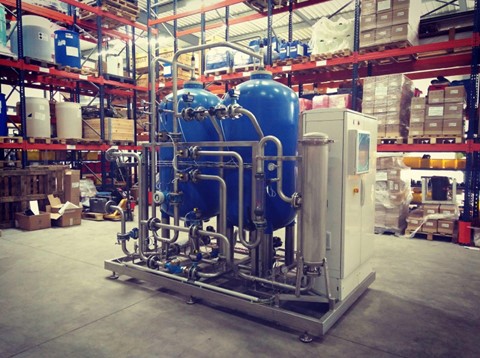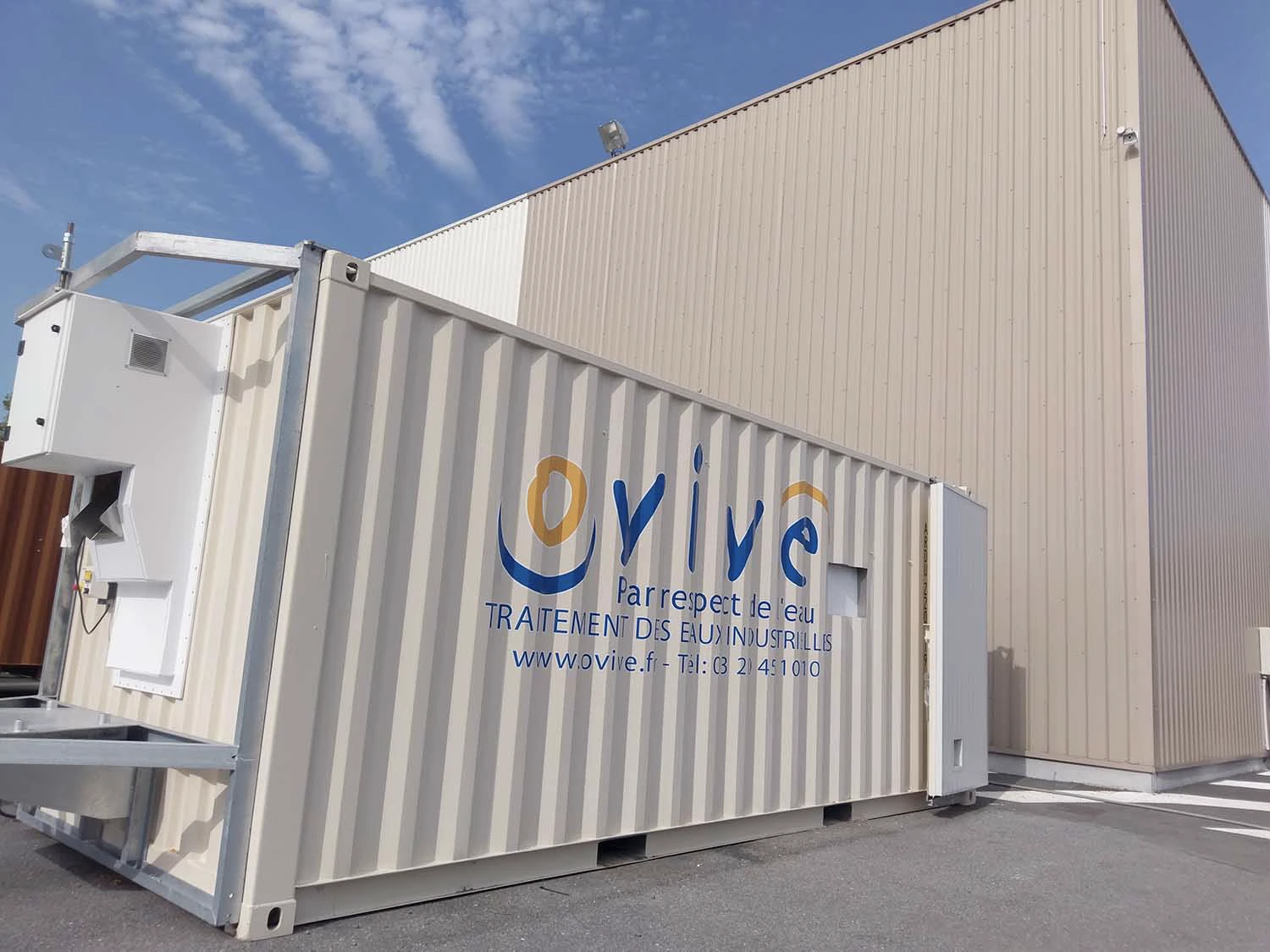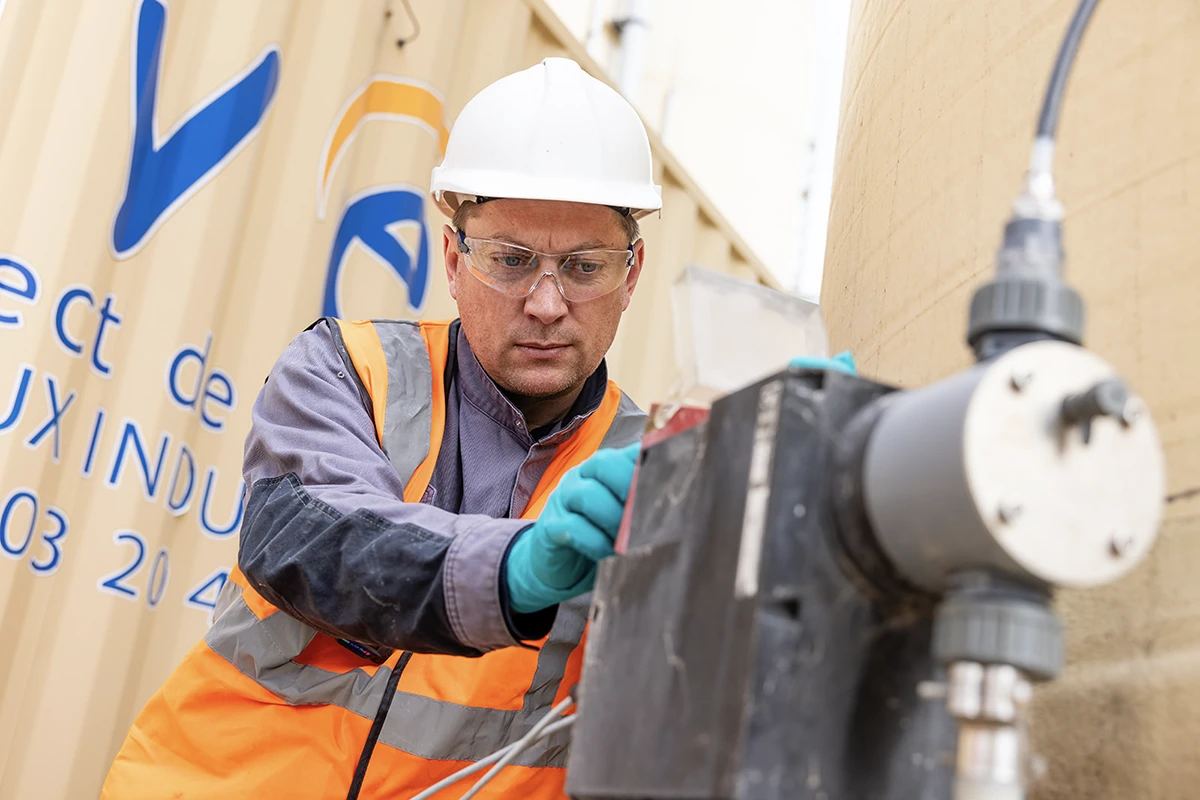Industrial wastewater disinfection
Improve the bacteriological safety of your effluents with Ovive’s expertise
Ensure a disinfection step that meets the challenges of environmental and health compliance, or of protecting your equipment and processes. Discover Ovive solutions, tailored to your needs.
Disinfection of treated wastewater: a key stage in industrial water treatment
Disinfection of treated wastewater is an essential phase in the industrial water treatment process. It is essential to eliminate or significantly reduce the presence of harmful micro-organisms such as bacteria, parasites and viruses, and prevent their proliferation further into the process or natural environment. These pathogens, when they persist in wastewater, pose serious risks to public health and are a direct threat to the environment. Disinfection is therefore essential to ensure the safety of water before it is discharged into the natural environment or reused in a variety of contexts.
Disinfection solutions
Various solutions based on oxidation-reduction processes can be used to disinfect water, by chemical means or UV irradiation and other advanced oxidation systems. Disinfection efficiency thus depends on the oxidizing power of the disinfectant. Chlorine gas and bleach are disinfectants regularly used for industrial water disinfection, thanks to their low cost and ease of use. Chlorine dioxide is a highly oxidizing agent, with high disinfectant, bleaching and deodorizing power. Its disinfectant action on micro-organisms is faster than that of chlorine, particularly on protozoa, and its residual effect is also more pronounced. The CATSy technology developed by Minerve Technology enables on-site disinfection using chlorine dioxide, with minimal by-product formation and corrosion. Ozone is a very powerful and reactive oxidant. Because of its high reactivity, ozone has no persistence. Other chemical disinfectants such as hydrogen peroxide, bromine, peracetic acid or potassium permanganate can be used in certain cases. UV irradiation provides fast, effective disinfection, with virtually no by-products. The UV solution is not remanent, and its effectiveness diminishes in cloudy effluents.
Disinfection objectives
The aim of disinfection is to inactivate pathogenic organisms present in the water, unlike sterilization, which seeks to totally eliminate these germs. The quality of disinfection is measured by the rate of removal of living organisms, as well as by the remanence of the oxidant and the rate of reactivation of micro-organisms by repair mechanisms. The choice of disinfection solution is therefore based on its effectiveness, potential negative effects, investment and operating costs, and safety and operating conditions.
Why disinfect treated wastewater?
There are many reasons why industries need to implement wastewater disinfection technologies.
Compliance with environmental regulations
Compliance with strict environmental regulations is a must. Numerous local and international laws require companies to treat their wastewater appropriately before discharge or use in TARs or boilers. This ensures that discharged water does not compromise water quality and the health of aquatic and human ecosystems (legionella risk).
Environmental protection and corporate image
Environmental protection is also a major concern for industry players. By adopting effective disinfection procedures, companies play an active role in preserving water quality, protecting aquatic biodiversity and reducing the ecological footprint of their activities. This environmental approach can also contribute to a company’s image, positioning it as a socially responsible player committed to sustainable development.
Water reuse
Disinfection is particularly key when it comes to water reuse. Thanks to advanced treatment methods, treated wastewater can be reused for a variety of applications, including but not limited to agricultural irrigation, industrial cleaning, plant cooling, and other non-potable uses. This reuse contributes to more sustainable management of water resources, enabling companies to make significant savings and reduce their dependence on external sources of fresh water. When treated water is reused in the process, good water disinfection also helps to preserve equipment and its availability.
The benefits of disinfecting treated wastewater for LWR
Disinfection of treated wastewater plays a pivotal role in the success of Treated Wastewater Reuse (TWR), particularly in industrial sectors where water demand is high. This sanitation process is essential for improving water quality, making it suitable for a variety of applications. Once treated and disinfected, this water can be used to irrigate green spaces, contribute to the preservation of water resources, cool industrial machinery, or be integrated into production processes. Optimized use of treated water not only increases the availability of this vital resource, but also considerably reduces the ecological footprint of industrial activities.
Environmental protection and public health
Disinfection makes a significant contribution to environmental protection by limiting the discharge of pollutant-laden wastewater. By effectively eliminating bacteria, viruses and other pathogenic micro-organisms, it minimizes the health risks associated with water reuse, ensuring the safety of populations and the preservation of aquatic ecosystems.
Disinfection technologies and methods
Disinfection technologies and methods are varied, each with its own specific features and advantages. Selection of the disinfection method should be guided by a thorough assessment of the specific needs of each application, taking into account raw water quality, treated water quality objectives, remanence requirements, and environmental considerations. This often involves a combination of techniques to achieve the desired level of quality, while optimizing costs and minimizing ecological impact.
Integrated strategy for sustainable management
The integrated approach to disinfection in the context of LWR thus represents a key strategy for sustainable water management, making it possible to meet the growing water needs of industry while protecting public health and the environment. The efficiency of the disinfection stage in a water reuse process is essential for the preservation of downstream equipment. Good design and operation are required to avoid the effects of corrosion due to the formation of harmful by-products or the unwanted growth of micro-organisms in the process.
Ovive’s complete solution for disinfecting treated wastewater
With expertise acquired since 1999, Ovive specializes in industrial water treatment and wastewater disinfection, offering a complete range of solutions including Minerve Technology chlorine dioxide disinfection (CATSy), chlorination, ozonation, UV, as well as advanced filtration and decantation systems for efficient elimination of waste and organic matter.
Regulatory compliance and environmental protection
Treating and returning more than 2 million cubic meters of water a year, Ovive helps manufacturers achieve regulatory compliance, protect the environment, optimize the use of water resources, and reduce operating costs. The reuse of treated water for irrigation, cleaning and cooling, and the recovery of by-products such as sludge as fertilizer, contribute to the circular economy and offer an economical and ecological solution. Ovive has been supporting industrial companies for almost 10 years in their projects to reuse water and recover valuable materials from effluents.
Personalized support
Ovive stands out for its personalized support, from needs analysis to the installation and monitoring of treatment plants, ensuring seamless integration of solutions into companies’ existing processes and guaranteeing continuous improvement in water quality and environmental performance. This strategic partnership offers not only cutting-edge expertise but also a commitment to sustainable management of water resources, reducing environmental impact and controlling health risks by eliminating pathogens, for a smooth transition to environmentally-friendly practices.
Economic and ecological benefits
By working with Ovive, companies not only benefit from improved water quality and equipment protection, but also make significant savings. The reduction in costs associated with the use of drinking water, combined with improved equipment availability and efficiency, translates into significant economic benefits. What’s more, Ovive’s commitment to reusing wastewater and reducing pollutant discharges underlines its active role in preserving water resources and promoting sustainable industrial practices.
By choosing Ovive, companies commit to an environmentally-friendly approach while optimizing their profitability and regulatory compliance, illustrating the balance between ecological responsibility and economic success.
Case studies
Ovive’s teams
as close as possible
to your needs.
A local partner, Ovive is present throughout France with 11 branches.
Find the branch nearest you!
















